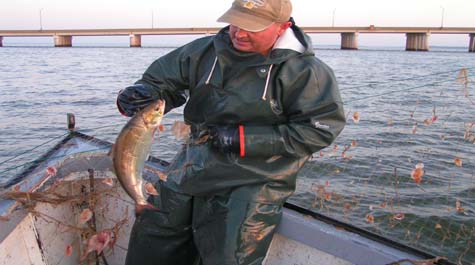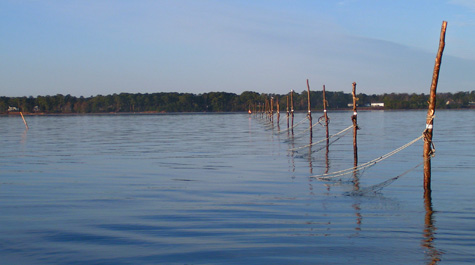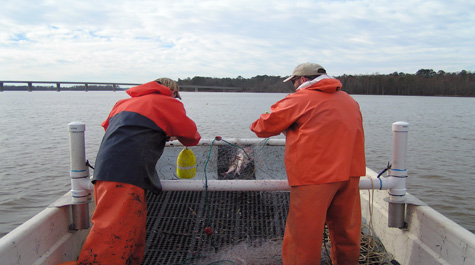Sampling Methods
Adult American shad
Gill Nets — VIMS used historical records of fishing locations to choose the current monitoring sites. One historical site from the James, York and Rappahannock rivers was chosen to monitor catch rates, using staked gill nets (SGN). Anchored Gill Nets (AGN) are currently used to fish on the James and York Rivers. Three AGN each 300 ft. in length are set and fished one day a week during the spawning season. One SGN stand 912 ft. in length is set on the Rappahannock River. This stand consists of 19 sectioned panels 48 ft. in length. A SGN is set and fished one day a week on the Rappahannock River during the spring spawning run. After the nets are fished they are hung in a non-fishing position until the next sampling event. Scientists accompany commercial fishermen during each sampling trip and all American shad are returned to the laboratory for analysis. All other species caught are counted, recorded on log sheets and released. Air temperature, surface water temperature and salinity are recorded at every sampling event.
Adult river herring
Anchored Gill Nets— Sites along the Chickahominy and Rappahannock Rivers were chosen to monitor adult catch rates using anchored gill nets (AGN). Nets are 300 ft. in length and consist of 2.5" and 3" stretched mesh. Four AGN (two 2.5" and two 3") are set on the Chickahominy River. Two AGN (one 2.5" and one 3") are set on the Rappahannock River. Nets are fished one day each week during the spring spawning run. All river herring are collected and returned to the lab for analysis. All other species caught are counted, recorded on log sheets and released. Air temperature, surface water temperature and salinity are recorded at every sampling event.
Juvenile American shad and river herring
Mamou surface trawl— Stations along the Chickahominy River, beginning two miles below Walkers Dam to the mouth of the river, are sampled using a Mamou surface trawl. The Mamou trawl is a 22 ft. x 6 ft. floating surface trawl constructed of 35mm high density polyethylene netting. The cod end is made from 36mm netting with a 20mm removable liner. The net consists of 50 ft. bridals connected to 36" x 18" floating mullet doors and 100 ft. tow lines. Stations are divided among four 5-mile river blocks. Within each river block three stations are sampled, totaling 12 stations per sampling trip. Each station is towed for 5 minutes. Weekly night-time sampling trips occur during the summer and early fall. All juvenile river herring and American shad are collected and returned to the laboratory for analysis. Other species caught are counted and released. Air temperature, surface water temperature, salinity and tide direction are recorded at all stations.




